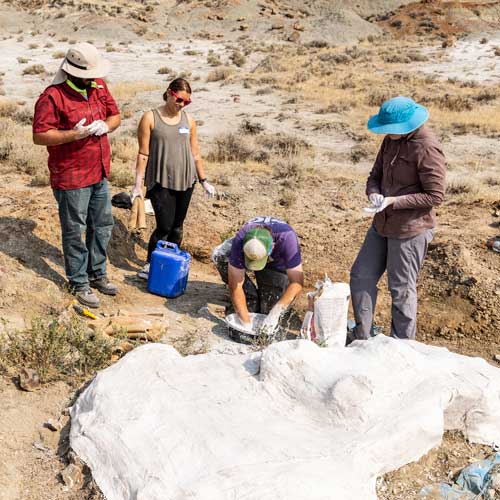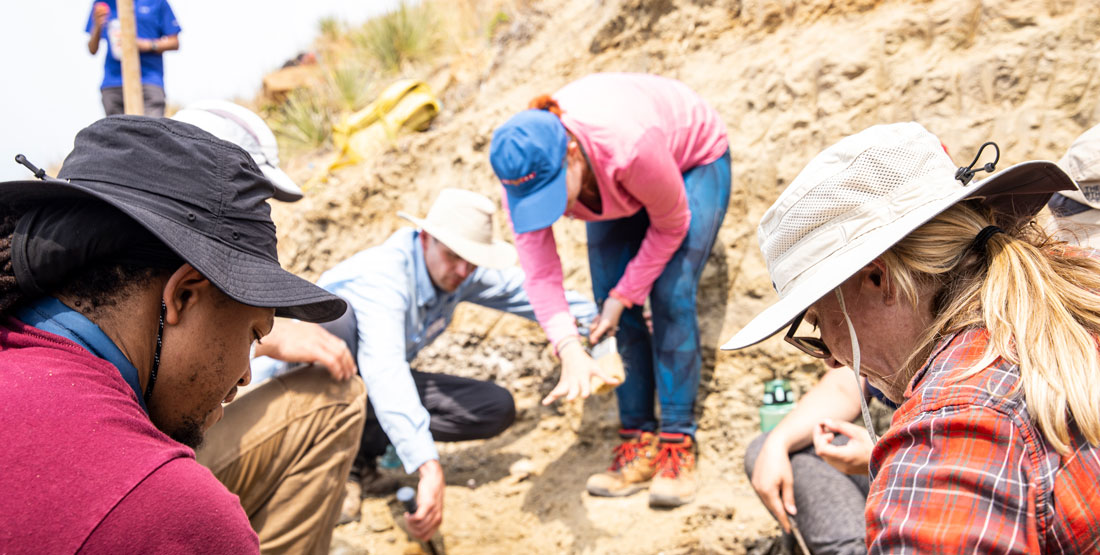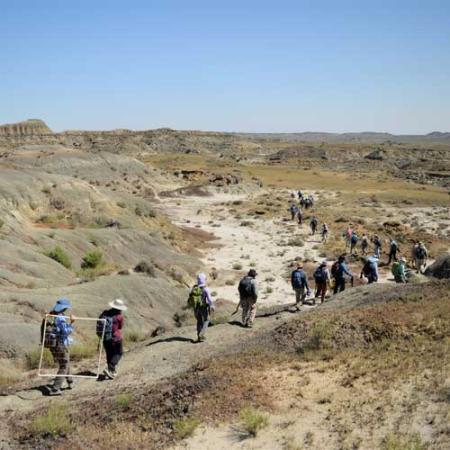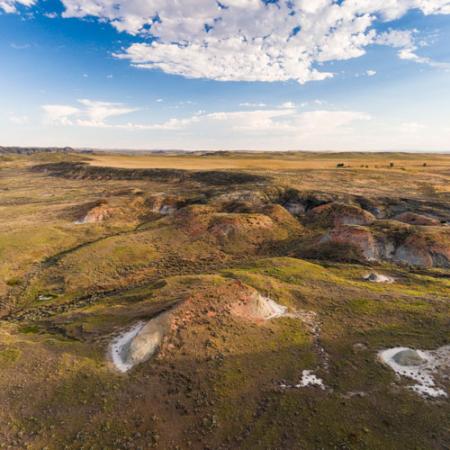Field School Overview
DIG Field School: Hell Creek
The founding DIG Field School takes place at the Hell Creek Recreation Area near Jordan, Montana — an area famous for preserving dinosaur fossils like Triceratops and Tyrannosaurus rex. The Hell Creek area is also renowned for its preservation of fossils from just before and just after the Cretaceous–Paleogene (K–Pg) mass extinction event, which occurred approximately 66 million years ago and marked the end of all non-avian dinosaurs. This area is an epicenter for paleontologists, geologists, and other scientists around the world, and is an excellent outdoor classroom.
Each year, we accept approximately 30–35 teachers into the Hell Creek Field School program, which typically takes place at the end of July.
DIG Field School: Petrified Forest
The new DIG Field School program, DIG Field School Petrified Forest (DIG PEFO), takes place in Petrified Forest National Park. DIG PEFO explores the rise of dinosaurs and includes excursions to Grand Canyon National Park to comprehend deep-time. On site research takes place within and around Petrified Forest National Park in eastern Arizona — an area famous for preserving fossil trees, early dinosaur fossils, and other archaic reptiles and amphibians. Petrified Forest National Park contains the first wave of dinosaur evolution but don’t be fooled — these early dinosaurs were the underdogs at the time and only rose to dominate the planet later. Like the Hell Creek area, Petrified Forest National Park remains an active research area, and is an excellent outdoor classroom.
DIG Field School: Stonerose
The new DIG Field School pilot program, DIG Field School Stonerose, takes place at the Stonerose Interpretive Center and Eocene Fossil Site in eastern Washington. DIG Stonerose is a shorter, three-day field school program specifically for Washington state teachers and administrators focused on paleobotany, paleoecology, and local geology. Learn more about Washington’s fossil record and geology and get hands-on experience with the tools and techniques paleobotany researchers use to uncover clues about life long ago.
During the DIG, participants will delve into ongoing research in the area and be full participants in the work we do—including collecting plants, insects, and other fossils! Days will be spent touring geology and paleontology sites, collecting fossils and geological data, and developing educational materials and activities. Evenings will include research talks and activities aimed to integrate your field experiences into your teaching.
DIG Stonerose will be piloting its program in fall 2026. The pilot cohort will be limited to 15 participants, but we are hoping to expand in future years.
DIG Microfossil Community Science Workshop
Can’t make it to field school? Attend our DIG Microfossil Workshop instead!
This one-day workshop offers educators a deep dive into the Hell Creek Project and illuminates how researchers use microfossils to model ecological extinction events and recovery. Participants will get a behind-the-scenes look at the Burke’s fossil prep labs and hands-on experience identifying microfossils as part of DIG’s ongoing community science research project.
The next DIG Microfossil Community Science Workshop is Saturday, January 24, 2026. Learn more and register.
In the Classroom
In addition to the field school component of the DIG, we provide K–12 educators and classrooms with educational resources available throughout the year. These resources include hands-on learning tools, classroom activities, and lesson plans developed by the Burke Museum Department of Education and DIG team. With these resources, students in K–12 classrooms participate in real UW research as they look for microfossils in sediment samples, examine fossil casts, and connect with scientists from many institutions. DIG's curriculum supports the Next Generation Science Standards (NGSS).
Team
Greg Wilson Mantilla, PhD is the Director of the DIG and is a Professor in the Department of Biology, Curator of Vertebrate Paleontology at the Burke Museum, and an Adjunct Professor in the Department of Earth and Space Sciences at the University of Washington. He is also a Research Associate at the University of California Museum of Paleontology and was a Curator of Vertebrate Paleontology at the Denver Museum of Nature & Science. He has been published in a number of prestigious scientific journals including Nature, Science, Geological Society of America Special Papers, Paleobiology, Journal of Vertebrate Paleontology, and Scientific Reports and has appeared in on-line reporting for the Huffington Post for his work in Hell Creek, Montana as well as Nature Podcasts and Science Daily. His research has been funded by a number of organizations including the National Geographic Society, NSF, USDA Forest Service, the American Philosophical Society, and the Paleontological Society.
Greg attended Stanford University as an undergraduate and received his PhD in Integrative Biology from the University of California, Berkeley in 2004 and was an NSF Postdoctoral Fellow at the University of Helsinki in 2005.
Brody Hovatter is a graduate student in the Wilson Mantilla Lab and assists DIG Director Dr. Greg Wilson Mantilla with management of the program. Brody is also a DIG Field School instructor and has worked with the program since 2015.
Devin Leatherman is Burke Box Manager, designing and building the Burke Museum’s Burke Boxes. These interactive programs use real museum collections to enhance learning opportunities in classrooms, libraries, homeschool environments, afterschool programs and even memory care facilities across Washington state. The launch of the redesigned DIG Boxes means Devin’s content now has a nationwide reach. With over a decade of experience in informal education, Devin built and implemented programming for several major museums in the greater Seattle area. She has a deep passion for using museum outreach programs to disseminate accessible, high quality, hands-on informal learning experiences to learners across the nation.
Rachael Canaday is the DIG Program Coordinator, supporting the administration of the DIG Field School Program and ongoing engagement between the Burke Museum, K-12 teachers and their students. Rachael has led programs and developed curricula for numerous museums and educational non-profits including the Seattle Aquarium, Pacific Science Center, National Geographic, and the Burke Museum. She is a former New York City public school teacher and taught elementary school STEM for ten years across multiple grade levels. Rachael loves bringing hands-on, object-based into classrooms and is excited to continue to expand teacher professional development opportunities through the DIG Program.
Sterling Nesbitt, PhD is the Director of DIG PEFO and is an Associate Professor in the Department of Geosciences at Virginia Tech and a research associate at many institutions across North America. He has studied the rise of dinosaurs and their close relatives and many of those discoveries have been made within Petrified Forest National Park. He has conducted fieldwork all around the world looking for early dinosaurs and kin.
Sterling attended the University of California, Berkeley as an undergraduate and received his PhD in Geosciences from Columbia University in 2009 and conducted research as a postdoctoral researcher at The University of Texas at Austin, University of Washington and the Field Museum.
Michelle Stocker, PhD is a Lead Instructor for DIG PEFO and is an Assistant Professor in the Department of Geosciences at Virginia Tech and a research associate at many institutions across North America. She is a world’s expert on phytosaurs (long-snout, crocodile-like predators from the Triassic) and other living and extinct reptiles. She is a major advocate for women in science.
Michelle attended the University of Michigan as an undergraduate, received her MS at University of Iowa, and received her PhD in Geosciences for The University of Texas at Austin in 2013.
Adam Marsh, PhD is the head paleontologist at Petrified Forest National Park. He studies the evolution of early dinosaurs and the vertebrate diversity within and beyond Petrified Forest National Park.
Adam attended Notre Dame as an undergraduate and received his MS and PhD in Geosciences for The University of Texas at Austin.
DIG Field School Instructors are a diverse group of university professors, postdoctoral researchers, graduate students, and postbaccalaureates from many different institutions including the University of Washington, University of California, Virginia Tech, University of Alabama, and more. These instructors bring their passion for paleontology and teaching every summer and are an invaluable part of the program.
Hands-on Experience
The Discoveries in Geosciences (DIG) Field School is a unique, non-profit education and outreach program for K-12 teachers created by Burke Museum paleontologists and now supplemented by Virginia Tech and National Park scientists.
Frequently Asked Questions
Can I get credit for attending the DIG Field School?
Yes! We are currently approved to offer free continuing education clock hours from the Washington State Office of Public Instruction (30 hours) as well as the option to receive college credit through the University of Washington Continuum College (additional fees apply). We are also happy to work with teachers from other states on getting approval for appropriate continuing education credits. Teachers are not required to apply for credits; teachers are responsible for any fees associated with their credits.
How much does it cost to participate in the DIG Field School?
There is a $300 registration fee to participate in DIG Field School Hell Creek.
The registration fee covers partial administrative costs for the program. Food, lodging, scientific equipment and ground transportation onsite are provided. This fee does not cover personal camping equipment (tent, sleeping bag, clothing, etc.) or fees associated with education credits (for example, if you want to receive credit through the University of Washington for attending, you will need to pay those fees yourself).
We also currently aren’t able to directly pay for travel costs (e.g., plane tickets, car transportation, etc.), although we do provide transportation from the Billings International Airport to the Hell Creek Recreation Area and back.
We do have limited financial assistance available for early career teachers (0-5 years' experience) and teachers at Title I schools or Rural & Low-Income Schools (RLIS). This includes registration fee waivers (up to $250) and as well as travel stipends (up to $500) to participants who need financial assistance to attend our field school.
If you have any additional questions, please send us an email.
Who can apply for the DIG?
We welcome applications from K–12 teachers in the US and across the globe! As of 2023, we’ve served teachers from 39 different states and are growing every year!
Where does the DIG Field School take place?
The DIG Field School Hell Creek takes place in the Hell Creek Recreation Area 26 miles north of Jordan, Montana.
The DIG Field School Petrified Forest takes place at Petrified Forest National Park in northeastern Arizona and includes a day excursion to Grand Canyon National Park.
Both DIG sites are famous for their preservation of fossils of dinosaurs and other organisms, and are a hub for scientific researchers around the world. During the DIG, instructors and participants eat, work, and tent camp together, providing an authentic and impactful experience.
The DIG Field School Stonerose takes place at the Stonerose Interpretive Center and Eocene Fossil Site in Republic, WA. The rocks around Republic preserve fossil leaves, flowers, fruits, and insects in exquisite detail and provides an excellent outdoor classroom for studying the evolution and ecology of fossil organisms. During the DIG, participants have the option to stay at local hotels in town or camp at Curlew Lake State Park nearby.
I'm not a teacher — can I still get involved?
Absolutely! You can read about volunteer opportunities at the Burke Museum, or email us if you have any questions. You can also subscribe to our newsletter for updates on our program and current events in the scientific event.
Interested in supporting the DIG? You can donate to our program here.

Stay in touch
Sign up for updates from the DIG Field School, including info about field work and research, application deadlines, and more.




